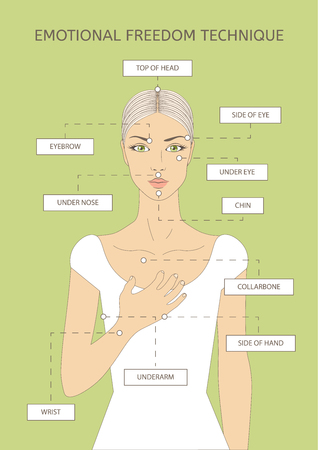EFT and Energy Psychology Therapy
Emotional Freedom Technique (EFT) comes from an area of therapy called Energy Psychology.1,2 Used as a tool to help alleviate symptoms stemming from stressors and past traumas, it is a psychological therapy based on the meridians of traditional Chinese medicine.1 Many studies have shown its effectiveness and reducing symptoms of headaches, depression, anxiety, phobias, insomnia, and intense emotional reactions from past traumas.1,3,4
Recent studies have shown that the types of patients who can use EFT also varies. From veterans with PTSD3, to children and students with test anxiety1, and anxiety in general4; Researchers are seeing positive results from patient-reported subjective scorings.1,2
The goal is to decrease the emotional intensity of a reaction from a past event or trauma by reducing the body’s stress response when an individual becomes “triggered.” In this way, it can be used to help individuals deal with past adverse childhood experiences, current pain they are experiencing (physical or mental/emotional), anxiety from particular stimuli, and even phobias.5
The 3 Components of EFT
The technique is relatively simple to follow, though gaining the assistance of a clinical practitioner may be warranted.
This is due to the fact that EFT is composed of 3 distinct and important techniques:
1) Physical stimulation of specific acupressure points (tapping)
2) Psychological exposure (recalling the trauma), and
3) Cognitive restructuring (self-acceptance) 5
For some individuals, practicing these techniques at home may be enough to reduce symptom intensity, however, for others, a guide may be needed to help identify the root emotional cause of the distress. Recalling the trauma may only require the idea of one specific instance. Whereas for other individuals, it might be a specific detail or feeling that came from a particular incidence.5
The Set-up
The set-up is created by evaluating a specific memory. Using a scale from 0-10, 10 being the most intense, distress and discomfort is measured as attention is brought to that memory or thought. The issue should be written down, trying to be as specific as possible. For example: I’m afraid to leave my house because I’m afraid to be around strangers and other people; or, I’ve lost control and can’t stop eating; or, I’m so angry and upset about the way my dad treated me as a kid. Writing down the issue and using it in this exercise acts as the means of exposure to the stressor.
“Setup Statement” or Positive Affirmation
That thought or memory is then turned into a “Setup Statement” or positive affirmation, which acts as a vector for self-acceptance. It’s best to keep the Setup Statement structured to start, but the arrangement can be changed if that works better for the individual. In general, the statement is “Even though I have [this problem], I deeply and completely accept myself.”5
Using the examples above, this would look like:
“Even though I have this fear of strangers and people, I deeply and completely accept myself”
“Even though I have this urge to keep eating everything in sight, I deeply and completely accept myself”
“Even though my dad was mean and couldn’t provide me with the support I needed, I deeply and completely accept myself”
This statement will act as your affirmation during the tapping technique. These statements will vary; The statement may be generalized and work just fine, but in other cases, it might be necessary to break down the statement to a specific aspect of the memory.
If it is difficult to put feelings into words, using a word bank or “feelings” word bank, which can be searched online, may provide some insight. Ones that include diagrams or pictures can equally work well for kids, to help them find their words.
The Physical Tapping
With a memory in mind, and a prepared Setup Statement, it can then combine with the last technique: tapping. The tapping is a literal tapping of the fingertips along acupuncture points to activate these areas, as well as send your brain a calming signal. Dawson Church, author of the “EFT Mini-Manual”5describes it as a signal “telling your brain that you are safe.”5 The memory might elicit a conditioned stress response, but the goal of EFT is to re-condition the brain and nervous system to decrease the intensity of the stress response.5
There is a vast collection of diagrams, pictures, and videos on the internet that can showcase the specific locations that will be tapped upon. However, the sequence should always be similar.
“Karate Chop” Point
First, Church recommends starting with the “Karate chop” point5: the fleshy outer side of your hand, between the knuckle of the pinky/baby finger and the wrist. Start by tapping 4 fingers along the “Karate chop” surface of your opposite hand. In general, each location may be tapped upon about 7 times, however, it may be beneficial to tap as long as it takes for a single breath in and out: Tap repeatedly on the inhale, and on the exhale for one full breath. Then transition to the next point.
After the Karate chop point, the sequence moves from the top of the head downwards, using the fingertips of just 2 fingers, the index and middle finger:
Start between the eyebrows, close to the bridge of the nose. Move along the eyebrows towards the outer edges of the eye sockets; Tap under the eyes along the bony ridge of the orbital bone. Next, tap the point in the middle of the philtrum (the ridges under the nose, above the upper lip). Move the fingers into the depression between the lower lip and the chin, and tap there as well. Then, find the small space between the clavicle (collarbone) and the first rib. Feel for the clavicle and move the fingers about 1-2 inches down, towards the heart. Feel for the space on either side of the sternum (breastbone), just below the clavicle. This point is also known in acupuncture as “Kidney 27.” And lastly, locate the point about 4 inches or so below the arm pits, at about the level of a bra band.5
Remember that the tapping should be solid, but without causing harm or bruising. It’s recommended to keep fingernails cut short, especially as tapping occurs close around the eyes. This also may be an exercise in sitting comfortably and monitoring the breath.
Putting it all Together – The Full Technique

Now that we understand all 3 areas of EFT separately, it is time to combine them for optimal efficacy. Once you’re comfortable with the tapping sequence, and have a Setup Statement prepared, do a quick check-in. Evaluate the emotional intensity on the trigger using the 0-10 scale. Begin to tap continuously, using four fingertips, on the Karate chop point while repeating your Setup Statement three times.
Use this statement, or shorten it to a few reminder words, and repeat them aloud as you work on tapping through the sequence above. Of course, it’s not absolutely necessary to say these statements aloud, but it does bring more power to the words and many practitioners agree that there may be more benefit to verbalizing the statement of self-acceptance.5 An alternative would be to strongly hold that thought in the mind, repeating it in your head with a deep focus on the words.5 Remember to allow a full breath for each point before transitioning to the next.
After the sequence is completed, it’s important to re-evaluate your emotional intensity by assigning your post-technique distress/discomfort on the same 0-10 scale. For many individuals, a single session can make a huge difference, for others, it may be helpful to continue EFT and use it as a tool for reducing acute anxiety.
For the Full Effect it’s Best Not to be Too Vague
Patients who have reported very nil effects from EFT, and still find an emotional charge remains, often either have used too general a statement, or have not addressed a specific aspect of the trauma that is still causing distress. Tapping on each aspect of the memory may be needed until the effect of the memory is neutralized. Though, it is not always necessary to work through every single horrible incident. Using one particular incident can be used to represent a collection of similar occurrences.5
Wide Variety of Resources on EFT Available Online
There are a wide variety of resources on EFT available online, many of which are free of charge. For those who are more visual learners, watching a video tutorial on YouTube may be helpful to understanding these techniques.
Sources:
- Chatwin, H., Stapleton, P., Porter, B., et al.“The effectiveness of cognitive behavioural therapy and emotional freedom techniques in reducing depression and anxiety among adults: A pilot study” (2016) Integ Med (Encinitas) 25(2): 27-34
- Nelms, J.A., and Castel, L. “A systematic review and meta-analysis of randomized and nonrandomized trials of clinical Emotional Freedom Techniques (EFT) for the treatment of depression” (2016) Explore (NY) 12(6): 416-26
- Suh, J.W. Chung, S.Y., Kim, S.Y., et al. “Anxiety and anger symptoms in Hwabyung patients improved more following 4 weeks of the Emotional Freedom Technique program compared to the progressive muscle relaxation program: A randomized controlled trial” (2015) Evid Based Complement Alternat Med.Epub 2015 doi: 10.1155/2015/203612
- Gaesser, A.H., and Karan, O.C. “A randomized controlled comparison of Emotional Freedom Technique and Cognitive-Behavioural Therapy to reduce adolescent anxiety: A pilot study” (2017) J Altern Complement Med.23(2): 102-8
- Church, D. “The EFT Mini-Manual” 2nd ed., (2012) Energy Psychology Press
Image Copyright: <a href=’https://www.123rf.com/profile_moremar’>moremar / 123RF Stock Photo</a>
Image Copyright: <a href=’https://www.123rf.com/profile_amaviael’>amaviael / 123RF Stock Photo</a>
 Dr. Sarah King is a licensed Naturopathic Doctor, graduating from the Canadian College of Naturopathic Medicine in 2014. Prior to completing her medical studies, she attended Nipissing University where she received her Honors Bachelor of Science in Biology. Sarah has a passion for women’s health and is a birth doula in Durham and Toronto Region. She treats a wide variety of health conditions including menstrual disorders and hormone balancing, fertility, prenatal care, digestive concerns, skincare and mental health/anxiety. Outside the office Sarah is an avid runner with a love of the GTA’s best forest trails. She also continues to improve her yoga practice and teaches breath work as part of stress management counselling to her patients.
Dr. Sarah King is a licensed Naturopathic Doctor, graduating from the Canadian College of Naturopathic Medicine in 2014. Prior to completing her medical studies, she attended Nipissing University where she received her Honors Bachelor of Science in Biology. Sarah has a passion for women’s health and is a birth doula in Durham and Toronto Region. She treats a wide variety of health conditions including menstrual disorders and hormone balancing, fertility, prenatal care, digestive concerns, skincare and mental health/anxiety. Outside the office Sarah is an avid runner with a love of the GTA’s best forest trails. She also continues to improve her yoga practice and teaches breath work as part of stress management counselling to her patients.

















